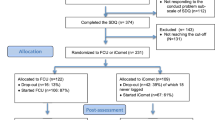Abstract
The long-term effect of two parent training programs for conduct problem preschoolers is reported. Families of 54 behaviorally disturbed preschool-aged children were randomly assigned to 1 of 3 treatment conditions: standard Parent–Child Interaction Therapy (STD), an abbreviated form of PCIT (ABB), and a no-treatment waitlist control group (WL). Of the families who completed treatment (STD and ABB), data were collected on 97% and 94% of families at 1- and 2-year follow-up, respectively. Follow-up assessment of parent report and independent observations indicated that treatment gains were largely maintained for both treatment conditions with little difference between the two treatments. The findings suggest that an abbreviated form of PCIT has long-term benefits for families with young children displaying early conduct problems.
Similar content being viewed by others
REFERENCES
Abidin, R. R. (1995). Parenting Stress Index—Professional manual (3rd ed.). Odessa, FL: Psychological Assessment Resources.
Achenbach, T. M. (1991). Manual for the Child Behavior Checklist/4–18 and 1991 profile. Burlington, VT: University of Vermont, Department of Psychiatry.
American Psychiatric Association. (1994). Diagnostic and statistical manual of mental disorders (4th ed.). Washington, DC: Author.
Arnold, D. S., O'Leary, S. G., Wolff, L. S., & Acker, M. M. (1993). The Parenting Scale: A measure of dysfunctional parenting in discipline situations. Psychological Assessment, 5, 137-144.
Beck, A. T., Steer, R. A., & Brown, G. K. (1996). Beck Depression Inventory manual (2nd ed.). San Antonio, TX: Psychological Corporation.
Cohen, J. (1988). Statistical power analysis for the behavioral sciences. Hillsdale, NJ: Erlbaum.
Eyberg, S. M. (1992). Assessing therapy outcome with preschool children: Progress and problems. Journal of Clinical Child Psychology, 21, 306-311.
Eyberg, S. M., Bessmer, J., Newcomb, K., Edwards, D., & Robinson, E. A. (1994). Dyadic parent–child interaction coding system-II: A manual (Social and behavioral sciences documents Ms. No. 2897). San Rafael, CA: Select Press.
Eyberg, S. M., Edwards, D., Bessmer, J., & Litwins, N. (1994). The workbook: A coder training manual for the dyadic parent–child interaction coding system-II (Social and behavioral sciences documents Ms. No. 2898). San Rafael, CA: Select Press.
Eyberg, S. M., Funderburk, B. W., Hembree-Kigin, T. L., McNeil, C. B., Querido, J. G., & Hood, K. K. (2001). Parent–child interaction therapy with behavior problem children: One and two year maintenance of treatment effects in the family. Child and Family Behavior Therapy, 23, 1-20.
Eyberg, S. M., & Pincus, D. (1999). Eyberg Child Behavior Inventory and Sutter-Eyberg Student Behavior Inventory—Revised: Professional manual. Odessa, FL: Psychological Assessment Resources.
Foote, R., Eyberg, S., & Schuhmann, E. (1998). Parent–child interaction approaches to the treatment of child behavior problems. In T. H. Ollendick & R. J. Prinz (Eds.), Advances in clinical child psychology (Vol. 20, pp. 125-151). New York: Plenum.
Funderburk, B. W., Eyberg, S. M., Newcomb, K., McNeil, C. B., Hembree-Kigin, T., & Capage, L. (1998). Parent–child interaction therapy with behavior problem children: Maintenance of treatment effects in the school setting. Child and Family Behavior Therapy, 20, 17-38.
Hedges, L. V. (1982). Estimation of effect size from a series of independent experiments. Psychological Bulletin, 92, 490-499.
Hembree-Kigin, T. L., & McNeil, C. B. (1995). Parent–child interaction therapy. New York: Plenum.
Hood, K. K., & Eyberg, S. M. (2003). Outcomes of parent–child interaction therapy: Mothers' reports of maintenance three to six years after treatment. Journal of Clinical Child and Adolescent Psychology, 32, 419-429.
Jacobson, N. S., & Truax, P. (1991). Clinical significance: A statistical approach to defining meaningful change in psychotherapy research. Journal of Consulting and Clinical Psychology, 59, 12-19.
Lyons-Ruth, K., Easterbrooks, M. A., & Cibelli, C. D. (1997). Infant attachment strategies, infant mental lag, and maternal depressive symptoms: Predictors of internalizing and externalizing problems at age 7. Developmental Psychology, 33, 681-692.
Nixon, R. D. V. (2002). Treatment of behavior problems in preschoolers: A review. Clinical Psychology Review, 22, 525-546.
Nixon, R. D. V., Sweeney, L., Erickson, D. B., & Touyz, S. W. (2003). Parent-interaction therapy: A comparison of standard and abbreviated treatments for oppositional preschoolers. Journal of Consulting and Clinical Psychology, 71, 251-260.
Reid, M. J., Webster-Stratton, C., & Hammond, M. (2003). Follow-up of children who received theIncredible Years intervention for oppositional–defiant disorder: Maintenance and prediction of 2-year outcome. Behavior Therapy, 34, 471-491.
Rogers, J. L., Howard, K. I., & Vessey, J. T. (1993). Using significance tests to evaluate equivalence between two experimental groups. Psychological Bulletin, 113, 553-565.
Rosenthal, R. (1991). Meta-analytic procedures for social research. Newbury Park, CA: Sage.
Shaffer, D., Fisher, P. S., Lucas, C. P., Dulcan, M. K., & Schwab-Stone, M. E. (2000). NIMH Diagnostic Interview Schedule for Children Version IV (NIMH DISC-IV): Description, differences from previous versions, and reliability of some common diagnoses. Journal of the American Academy of Child and Adolescent Psychiatry, 39, 28-38.
Webster-Stratton, C. (1990). Long-term follow-up of families with young conduct problem children: From preschool to grade school. Journal of Clinical Child Psychology, 19, 144-149.
Webster-Stratton, C. (1993). Strategies for helping early school-aged children with oppositional defiant and conduct disorders: The importance of home-school partnerships. School Psychology Review, 22, 437-457.
Webster-Stratton, C., & Hammond, M. (1988). Maternal depression and its relationship to life stress, perceptions of child behavior problems, parenting behaviors, and child conduct problems. Journal of Abnormal Child Psychology, 16, 299-315.
Author information
Authors and Affiliations
Rights and permissions
About this article
Cite this article
Nixon, R.D.V., Sweeney, L., Erickson, D.B. et al. Parent–Child Interaction Therapy: One- and Two-Year Follow-Up of Standard and Abbreviated Treatments for Oppositional Preschoolers. J Abnorm Child Psychol 32, 263–271 (2004). https://doi.org/10.1023/B:JACP.0000026140.60558.05
Issue Date:
DOI: https://doi.org/10.1023/B:JACP.0000026140.60558.05




